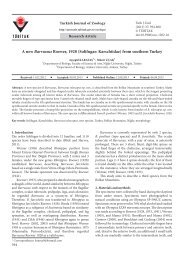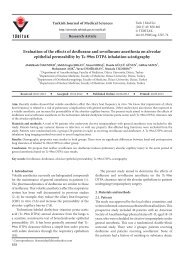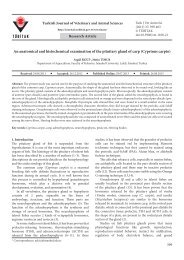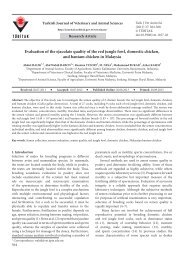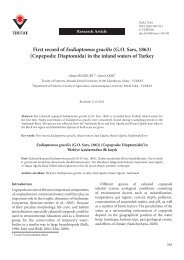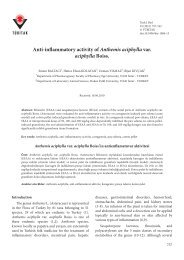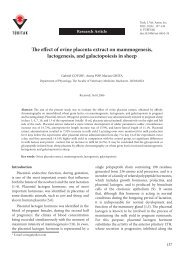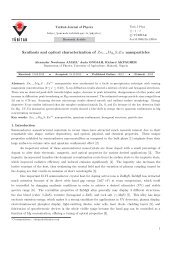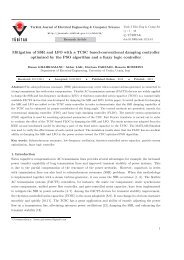Preliminary study on Acropora - Scientific Journals - Tübitak
Preliminary study on Acropora - Scientific Journals - Tübitak
Preliminary study on Acropora - Scientific Journals - Tübitak
You also want an ePaper? Increase the reach of your titles
YUMPU automatically turns print PDFs into web optimized ePapers that Google loves.
Figure 9. <strong>Acropora</strong> nasuta: a) porti<strong>on</strong> of col<strong>on</strong>y; b) porti<strong>on</strong> of<br />
branch; c) SEM micrograph showing terminal part of branch; d)<br />
SEM micrograph showing coenosteum <strong>on</strong> a radial corallite; e)<br />
fr<strong>on</strong>t view of few radial corallites; f) top view of an axial corallite;<br />
g) SEM micrograph showing coenosteum between radial<br />
corallites.<br />
Descripti<strong>on</strong>: Branching pattern: Arborescent (Figure<br />
10a); branches thin and l<strong>on</strong>g (maximum 110 mm),<br />
slightly tapering (Figures 10b and 10c); branch diameters:<br />
8.0–12.2 mm, 7.5–11.2 mm, and 5.0–6.6 mm; growth<br />
indeterminate.<br />
Axial corallites: Small but slightly larger than large radial<br />
corallites; outer diameter 2.0–2.8 mm; calice diameter<br />
1.0–1.4 mm; wall thickness about half the calice diameter;<br />
oval opening; 1 complete septal cycle present up to 3/4R;<br />
directive septa larger than the others, sometimes touching<br />
at bottom of calice; sec<strong>on</strong>dary septa usually absent, but if<br />
present, <strong>on</strong>ly developed to maximum 1/4R (Figure 10g).<br />
Radial corallites: Arranged in rows <strong>on</strong> branches, 2 sizes,<br />
tubular, round opening; calice large compared to radial<br />
size (Figures 10b and 10d); profile length 2.05–2.83 mm;<br />
appressed and subimmersed corallites scattered <strong>on</strong> the<br />
bases of main branches; septa poorly developed, primary<br />
septa up to 1/4R, some septa dentate, sometimes <strong>on</strong>ly<br />
directive septa present; sec<strong>on</strong>dary septa absent.<br />
316<br />
RAHMANI and RAHIMIAN / Turk J Zool<br />
Coenosteum: Covered with elaborate, laterally flattened<br />
spinules, both <strong>on</strong> and between radial corallites (Figures<br />
10e, 10f, and 10h).<br />
Color: Pale yellow or dark cream to pale brown.<br />
Remarks: So far, <strong>Acropora</strong> tortuosa has <strong>on</strong>ly been<br />
recorded in the western and central Pacific Ocean<br />
(Wallace, 1999). Its presence in the Persian Gulf is therefore<br />
remarkable. For c<strong>on</strong>firmati<strong>on</strong>, a specimen of this species<br />
was shipped to the Museum of Tropical Queensland, where<br />
it was identified as <strong>Acropora</strong> cf. tortuosa by C.C. Wallace.<br />
Later <strong>on</strong>, with more detailed studies <strong>on</strong> the morphology<br />
and other characteristics of the col<strong>on</strong>y, it became clear that<br />
the specimen was indeed <strong>Acropora</strong> tortuosa. C<strong>on</strong>sequently,<br />
this is the first record of A. tortuosa from the Persian Gulf.<br />
Morphologically, the specimens of A. tortuosa from<br />
the Persian Gulf were very similar to those described<br />
by Wallace (1999), except that the branches were a little<br />
l<strong>on</strong>ger and the walls of axial corallites were thinner in the<br />
Persian Gulf specimens.<br />
Figure 10. <strong>Acropora</strong> tortuosa: a) fresh col<strong>on</strong>y out of water; b)<br />
porti<strong>on</strong> of branch; c) porti<strong>on</strong> of col<strong>on</strong>y; d) SEM micrograph<br />
showing terminal part of branch; e) SEM micrograph showing<br />
coenosteum <strong>on</strong> a radial corallite; f) SEM micrograph showing<br />
close up view of coenosteum <strong>on</strong> radial corallite; g) top view of<br />
axial corallite; h) SEM micrograph showing coenosteum between<br />
radial corallites.



